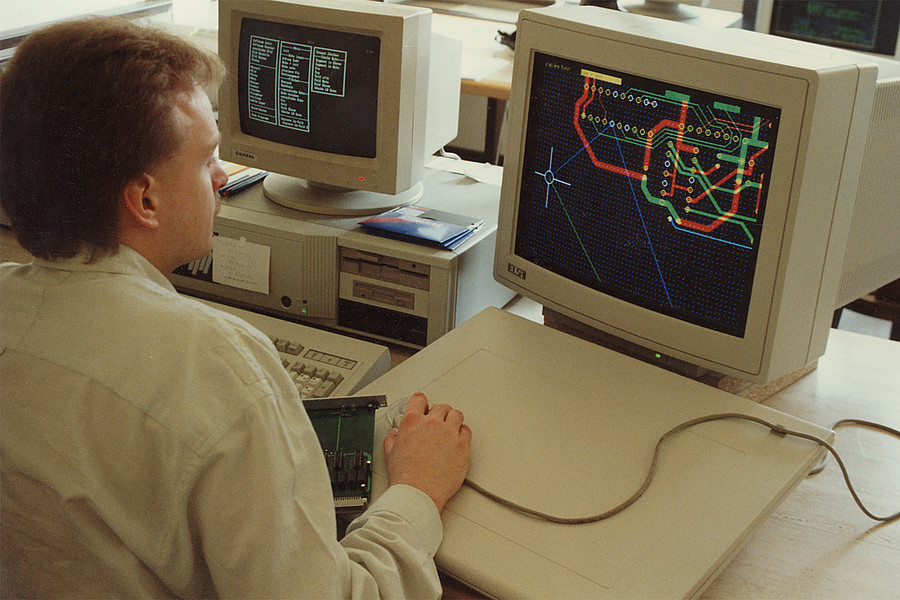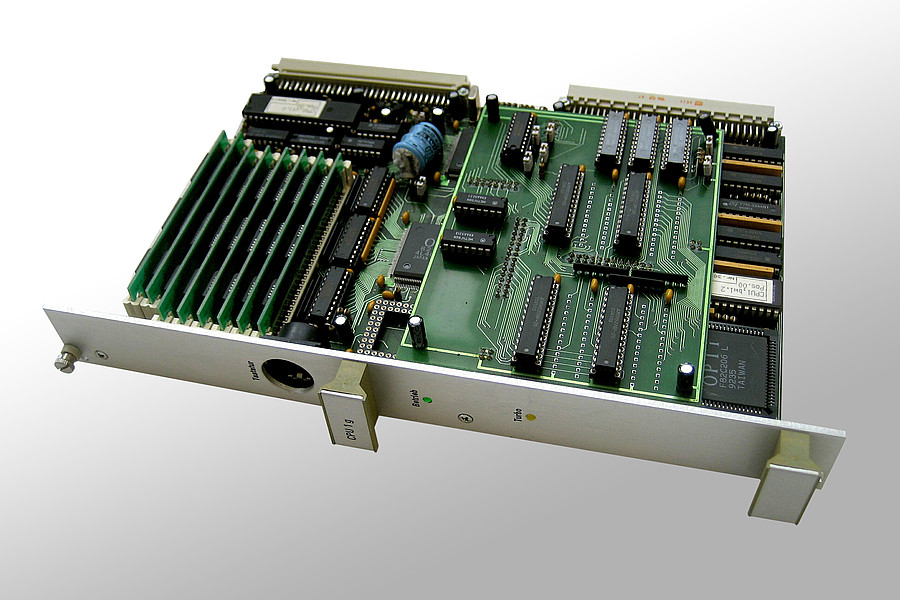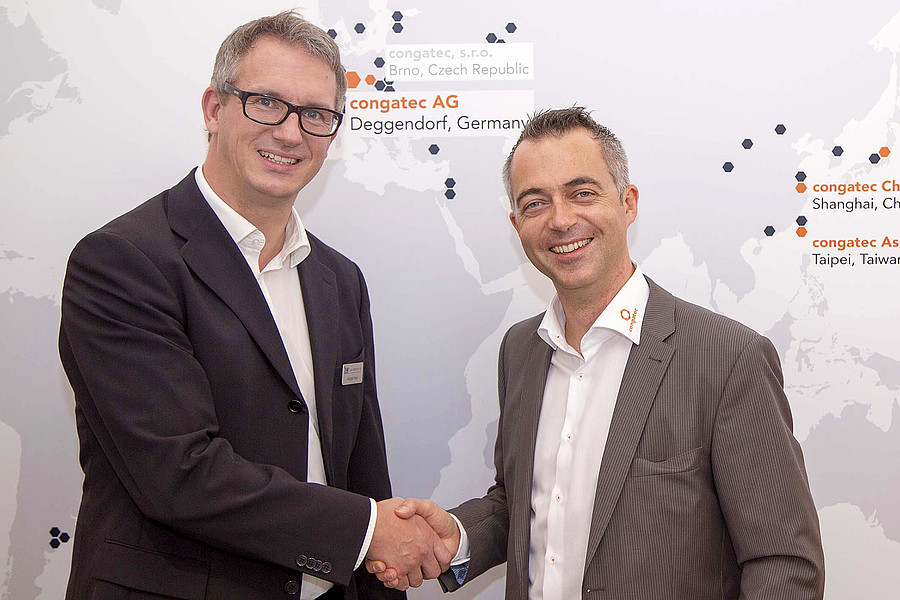History
- 1966: Foundation of the company
-

Industrie Elektronic Schmitz KG, founded on 16 May 1966, moves that same year into new office space in Kierspe "An der Luiseneiche". Right from the start Ludwig Valder, responsible for planning and sales, as well as Hans-Jürgen Mähnert, all-rounder in all things technical, support Friedhelm Schmitz and his wife Charlotte in their endeavours. In its first year after foundation, the company begins hiring new staff; the newly designed “Schmitz” logo comes into use.
- 1967: Wehestraße
-

In 1967, a new location is required to accommodate the growing development and production of electronic semiconductors, components and plants. Along with its relocation to Wehestraße in Kierspe, the number of staff at Industrie Elektronic Schmitz KG grows to a total of 15 in 1970. The first consignments are thoroughly documented by photograph and shipped to the clients - at the time mainly utility providers.
- 1970: The development of U100M
-

U100M is one of the first programmable logic devices in the German semiconductor market: Between 1970 and 1972, Telefunken developed and produced the device on behalf of Industrie Elektronic Schmitz. Subsequently, it was successfully marketed as part of the U100 product family. Comprising approximately 100 programmed gates, the device can be used to record a diversity of fault values; it is exclusively used on the company’s proprietary registration cards.
- 1975: Friedrich-Ebert-Straße
-

In 1975, the company relocates from its premises at Wehestraße into the former administrative buildings of Bakelit processor Dr. Deisting GmbH & Co. KG, formerly the largest employer in Kierspe. Continuing the vibrant industrial tradition that this location has seen since 1909, Industrie Elektronic Schmitz now produces and sells its products on 600 square meters of space. Along with its relocation, the company now develops systems for the automation of cement manufacturing plants and sells them around the world.
- 1977: The development of STK
-

In 1977, Industrie Elektronic Schmitz develops the first ‘STK’ control unit for the automation of pneumatic dispatch control systems. Programming can be customized, therefore the unit can be deployed universally. Featuring hard-coded circuit logic as well as additional manually-made wire-wrap connections, it enables a wide range of control functionalities. That way, more than 100 different function components can be assembled and connected using only 8 different versions of circuit boards.
- 1978: Cement manufacturing plants
-

The expertise generated in Kierspe is in high demand, not only in Germany but indeed around the world. In cooperation with the Polysius company, a consistent system for the control and automation of cement manufacturing plants - by far superior to the state of the art at that time - is developed and put into operation on-site. In Pakistan, Iran, Iraq, Malaysia, Thailand, Korea, China and Vietnam, cement has to some extent been manufactured using plants provided by Industrie Elektronic Schmitz.
- 1979: The first 8-bit microprocessor
-

In 1979, Industrie Elektronic Schmitz develops the BPU slot-in card series for control technology which is based on the 8085 8-bit microprocessor by Intel. The entire computing and storage unit is implemented on a card the compact European size of 100 mm x 160 mm. It communicates with input/output, interfaces and adapter cards via the proprietary B-backplane bus standard. At the end of the 1970s, a software department is established to program the BPU-based systems.
- 1981: The development of Polcid-DC
-

Simultaneous to the development of the AT96/ISA96 bus by Siemens, Industrie Elektronic Schmitz develops the VG ledge based SKP-16 bus and makes it the key component of the ‘Polcid-DC’ control system for the cement industry. Central processing unit is the high-performance PDP computing architecture offered by Digital Equipment Corporation, featuring a 32-bit data bus (LSI11). That way, control systems the size of a 19 inch cabinet are able to process more than 8,000 I/O signals at the same time.
- 1984: Dr. Steger joins the company
-

On 1 July 1984, Dr. Gerhard Steger joins the company as technical director, complementing the management team around founder Friedhelm Schmitz and sales director Ludwig Valder. It is under his guidance that the ‘MPX’ analytical gate array for fault value printers is developed jointly with chip manufacturer Micron Technology. It can analyze up to 4,096 signals with a resolution of one millisecond and a minimum signal interval of 128 microseconds in the correct sequence.
- 1987: The development of microCAD
-

Industrie Elektronic Schmitz cooperates with engineering office Bodo Jaeger to develop microCAD, a user-friendly CAD system for circuit diagram design, circuit board layout and placement as well as generation of parts lists. Second to no other technology, the system is customized to fit individual requirements. High demands for resolution and speed of the graphic presentation lead to the development of a proprietary ISA bus graphics card that can be connected to up to eight 21-inch monitors.
- 1991: The first x86 single-board computer
-

In 1990, 47 staff members from development, production, construction and testing develop CPU1, a proprietary single-board computer in European size with an Intel 80386 main processor and an OPTi chipset for use as floor computer in 19-inch magazines. One year of development work down the road, on the first day of its deployment, this component boots right up to the DOS prompt - an outstanding development performance.
- 1993: Embedded computing modules
-

Starting in 1993, Industrie Elektronic Schmitz focuses on computing modules offered by JUMP, a start-up company based in Deggendorf. The AT96-Sdisk1 computing module featuring a 486DX processor is used in the new CPU4 module - successor of the CPU1 module with 386DX processor, developed in-house in the 1980s. On another note, the company enters into an agreement with JUMP about the intensification of their technical and strategic cooperation. JUMP is an important technology partner for the development of long-term available IPCs.
- 1995: Fieldbus coupler modules
-

In order to make Polcid-DC available to other users, Industrie Elektronic Schmitz designs compact coupler modules for the proprietary SKP-16 bus, using the intelligent Interbus-S controller module “Su-pi II” by Phoenix Contact. The format initially used was European size; later it was changed to Interbus-S module technology - the latter always featuring an 80186 processor for pre-processing and for monitoring and control.
- 1997: The new management
-

On 1 January 1997, company founder Friedhelm Schmitz (67) hands the business over to his daughter Katrin Schmitz (28, business director) and Dr.-Ing. Gerhard Steger (51, technical director). As of now, the company calls itself industrie elektronik schmitz gmbh (ies). The development of the paperless multiple writer 16PEM1 based on PC104 technology is an important step towards the development of new use scenarios for embedded computing modules by JUMPtec.
- 2000: The restructuring
-

Based on the PISA, ETX and DIMM-PC form factors and in close cooperation with JUMPtec, Dr. Gerhard Steger develops the new business division ‘Embedded Computer Systems’. As a result, computing systems can be designed in a modular and flexible manner which until then has not been considered possible. On 1 April, Martin Steger joins the company with a focus on the expansion of the new business division. In the autumn of that year, ies presents the first operable ETX baseboard at the electronica trade fair in Munich.
- 2002: ETX certified partner
-

From 1 January 2002, ies is official distributor for all JUMPtec products. Shortly thereafter, the company acquires the “ETX certified partner” certificate for the form factor which is rapidly gaining popularity. In April, JUMPtec awards the first “ETX certified partner” trophy to ies. Due to the merger of JUMPtec AG and Kontron AG in mid 2002, ies expands its portfolio with a range of new products and technologies and further builds on the existing business relationship with Kontron AG.
- 2004: X-board form factor
-

Spurred by innovative embedded computer modules and the success of the ETX form factor, Kontron has by 2004 introduced the open standards X-boards, JRex, JFlex, speed-MOPS and ePanel. It is particularly the X-board form factor which enables ies from now on to build full-scale x86 computing systems in compact size. In 2004, ies puts MB28 into operation, the first carrier board based on this form factor, which enables the company to tap the market for automotive computing systems.
- 2005: Sales Partner Award
-

At the annual meeting of the Kontron sales partners, ies is awarded a prize for being the most successful design-in partner in the Pentium M mobile processor generation. This and the fact that ies has risen among the top 5 of the internationally best performing sales partners underlines the important position of ies as a systems partner for the very latest processor technologies. The award is handed over by Eberhard Wüst of Intel during the award ceremony held in Fuengirola, Spain.
- 2007: COM express modules
-

For the first time, ies uses computer modules of the “COM express” form factor for the development of customer specific computer components. Initially slightly upstaged by successful ETX technology, this form factor is only slowly put at the focus of new projects. The unique selling points of processor performance and interfaces, e.g. PCI express x1 - x16 as well as GBit Ethernet, and the increasing demand for such performance pave the way for a new era at ies.
- 2008: The younger generation takes over
-

On 20 November 2008 after serious illness, longstanding and highly respected managing director Dr.-Ing. Gerhard Steger dies at the age of only 63. Starting in 1997, he worked successfully at shifting the company from an automation specialist for power plant, process and emission technology to a modern and diversified provider of products and services for embedded computing technology. Martin Steger takes over the company management.
- 2009: Relocation to Meinerzhagen
-

As of 1 January 2009, after more than 55 years of doing business ins Kierspe, ies headquarters are now located in the new building in “Darmcher Grund” in Meinerzhagen. In no time the premises, fully tuned to the company’s requirements, bring significant improvements to not only the work flows but also to the working spirit. The development of more than 7,500 different components and variations thereof since its foundation in 1966 is the highest rate ever achieved by the company.
- 2010: Significant growth
-

A solid customer base, a largely unchanged number of staff as well as long years of know-how in embedded computing technology account for a 25% sales increase at ies. An unusual order increase during the second half of the year ensures an all-time high order backlog at the end of the year. This has been achieved through long-term supply agreements for existing products, but also through the development of new product lines that are strategically important to automation, communication and medical technologies.
- 2012: The new sales office North
-

In 2012, ies inaugurates its own sales office in the north of Germany with a view on improving support for important key account customers in that area. This follows the opening of its sales office South in 2009 for customers in Southern Germany, Austria and Switzerland; the ies sales team has grown to a total of six members, taking care of the entire range of tasks such as order management and back office work. For the seventh consecutive time, the book-to-bill ratio is larger than one.
- 2013: embedded NUC
-

embedded NUC is a new industrial standard for small form factor computers, inspired by Intel® NUC (Next Unit of Computing) systems. By adapting NUC to industrial applications, a number of computing functionalities can be offered as embedded system in a new compact format. ies is among the pioneers for embedded NUC. Since Martin Steger is chairman of the SDT.03 standardization committee at the SGeT association, the company takes a leading role in designing the open industrial standard.
- 2014: congatec sales partner
-

After more than 20 years of exclusive sales partnership with Kontron AG, ies expands its strategic partner network to include congatec AG, another internationally leading manufacturer of embedded computer components. The sales partnership with congatec is an important step in the systematic development of the company’s business strategy and enables ies to provide its customers with a competitive edge and cost benefits in the medium and long term.
- 2015: Manager of the Year
-

The renowned ‘Markt & Technik’ industry magazine votes Martin Steger Manager of the Year for embedded systems. That same year, he is nominated for the ‘Südwestfalen’ business award and voted among the three top managers. Martin Steger receives those two business awards in recognition of his entrepreneurial activities in the region and beyond as well as his engagement in the standardization of embedded systems.
- 2016: ies turns into iesy
-

After 50 years, the name change to iesy marks the dawn of a new era. The motto “This is simple. This is iesy.” is a promise of simplicity and from now on the company’s new guiding principle. Along with the name change, the company presents itself in a new corporate design which connects the history of ies with the future of iesy. Also, iesy develops an open source hardware module for the Beagle Core project which is based on the BeagleBone Black and has the size of a stamp.
- 2018: embedded Mini-STX
-

In cooperation with congatec, iesy presented a new form factor named Mini-STX during embedded world 2018. Measuring 140 mm x 147 mm, the new form factor offers plenty of space for interfaces and cooling solutions despite its compact dimensions. With up to 4 x 10 GBit Ethernet, 3 x M.2 sockets and integrated baseboard management controller as well as a consistent high-speed design with COM Express Type 7, the new form factor is predestined for use as a micro server in Industry 4.0 solutions directly on the shop-floor.
- 55th anniversary
-

iesy turned 55 on 16 May 2021. On that day 55 years ago, the Mr. Friedhelm Schmitz and his wife Charlotte founded the company "Electronik Schmitz KG" in Kierspe.
Since that time, iesy has developed strongly as a company and is currently setting further milestones. An extension to the existing company building is currently under construction. This will expand the existing production and office capacities by another 2,000 m² and will provide space for more good ideas and innovations to jointly inspire new products, new markets, new customers as well as new team members for us.

